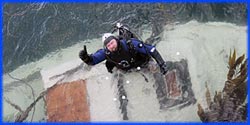


Premier Date: November 18, 2009
confirmed
The MythBusters did this test after some viewers doubted their estimates in the original exploding water heater myth. They set up a full sized 52 US gallon (200 L) water heater and removed all safety mechanisms and covered it with blankets to speed up heating. After the eventual explosion, Adam used high speed footage to reveal that the unobstructed water heater shot up 560 feet (170 m) at a speed of 350 miles per hour (560 km/h), which was near their estimates in their original test.
plausible
The MythBusters set up a three-tier scaffold to simulate a two-story house. The lowest level housed the 52 US gallon (200 L) water heater, second level contained a simulated living room, and on top was a roof built to standard California building codes. The resulting explosion from the water heater did cause it to shoot through the living room floor and the roof. It was deemed plausible because, unlike the original myth, researchers did not uncover any documented events of water heater explosions in two-story houses.
confirmed
The device does exist; kari used the device, called the “CornerShot”, to successfully shoot a target positioned around a corner.
busted
Because Grant could not see the target, all of his shots missed.
plausible
Tory hit the target using this technique and landed on a mattress that had been placed to break his fall. However, chances of doing this in a real-world setting (i.e. no mattress on which to land and the target shooting back) are slim.
confirmed
Jamie stayed on the top of the car, even though he let go seconds before the car crashed through the wall. It should be noted that some boxes were hit by the front end of the rig and only one box directly hit him.
confirmed
Adam stayed on the car despite feeling what he described was a force acting on his feet from the boxes. Upon closer inspection of the high speed footage, Adam actually let go of his grip on the hood and slid up the windshield. He then regained his grip on the hood just as he was about to fall off the car. Since the loss of his grip happened so fast for anyone to notice, this myth was deemed confirmed.
confirmed
It took Tory four seconds using a hammer and crowbar to break a padlock at room temperature. After a second lock was sprayed with liquid nitrogen for five minutes, he was able to break it in one hit. The Build Team then tested a door locked with a deadbolt; Tory required over five minutes to smash it at room temperature, but less than two minutes after it had been frozen. Grant pointed out that the method would require so many people, and so much time and specialized equipment, that it would not be a practical or stealthy way of breaking into a building. Nevertheless, the team declared the myth confirmed.
busted
A wedge entirely made of steel was made and then installed onto a rocket sled to represent the snowplow. The surrogate snowplow traveled a total distance of 770 feet (230 m) and struck the car at a speed of 550 miles per hour (890 km/h), completely splitting it along its length with a thrust of 7,500 pounds (3,400 N). Afterwards, the wedge disintegrated when the rocket sled slammed into a concrete barrier behind the car. The Build Team still regarded the myth as busted because an average motorist is highly unlikely to encounter a snowplow traveling with enough speed to destroy a car in this manner.
Previous: Episode 130: Crash and Burn